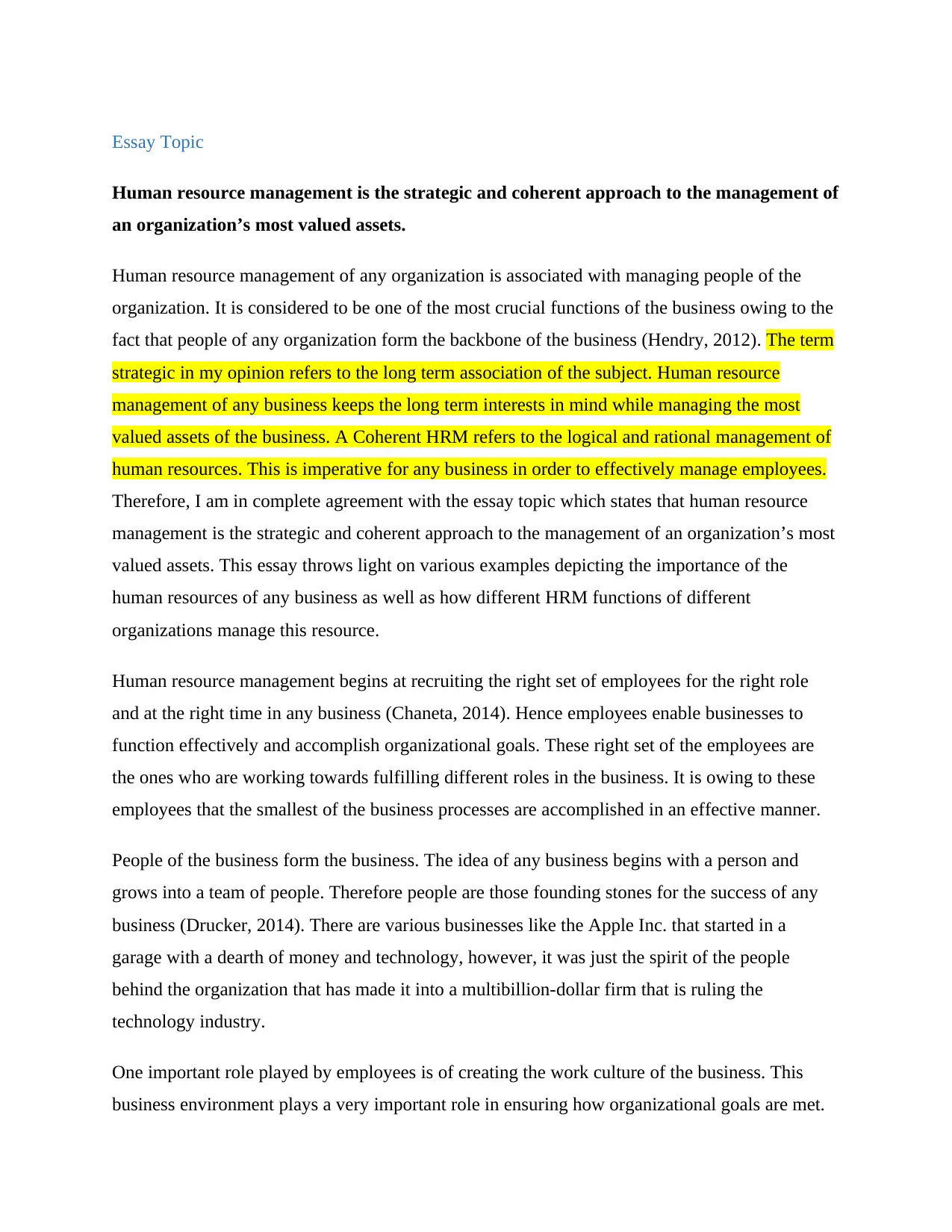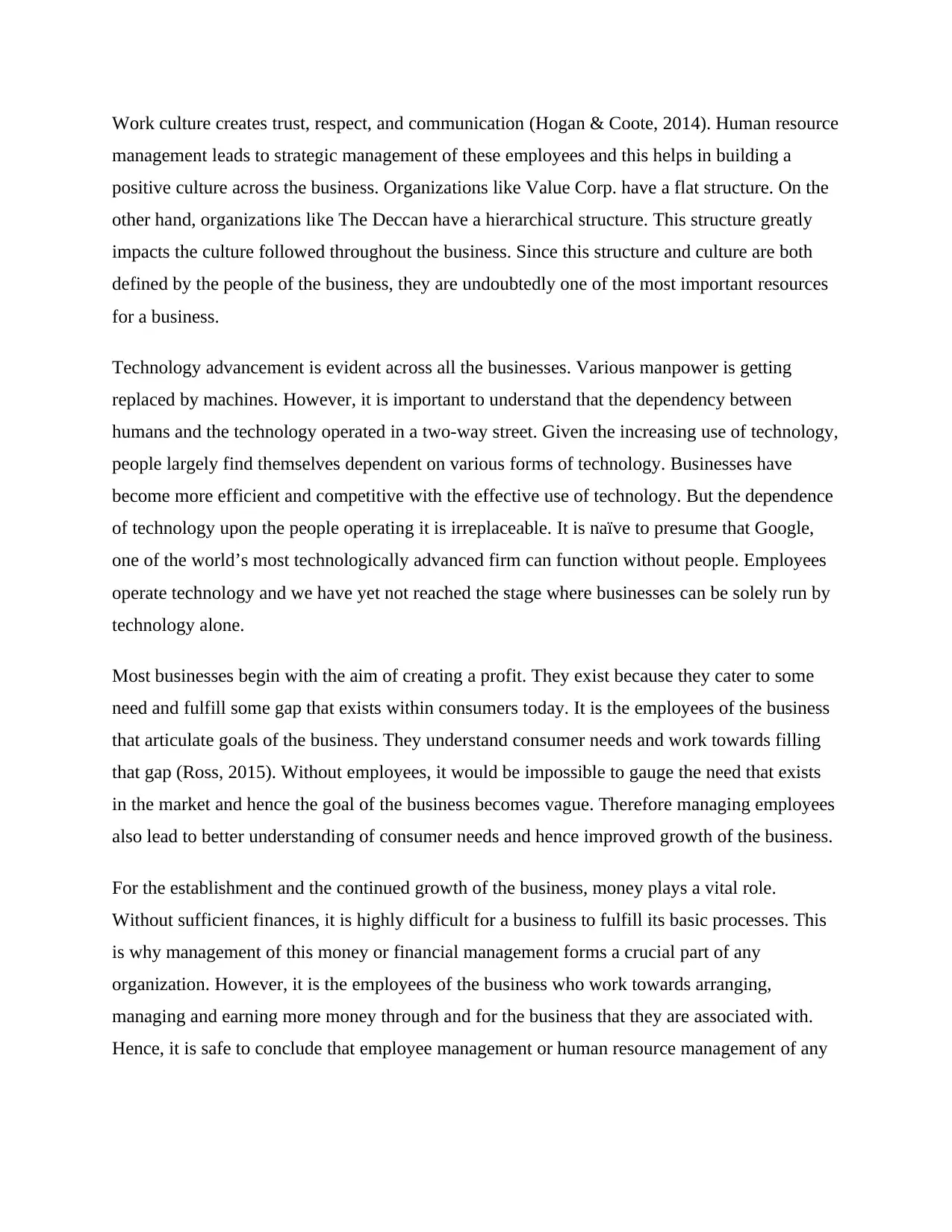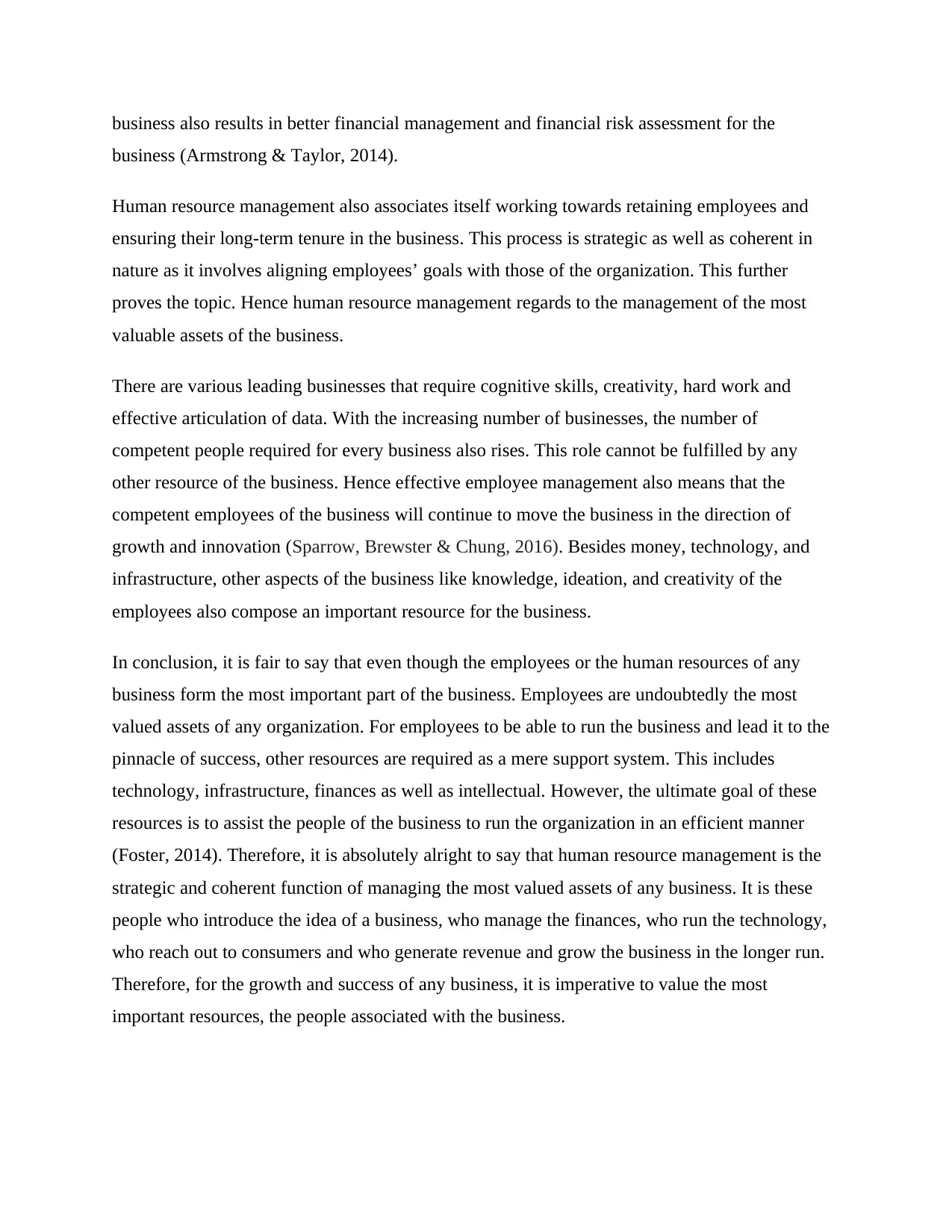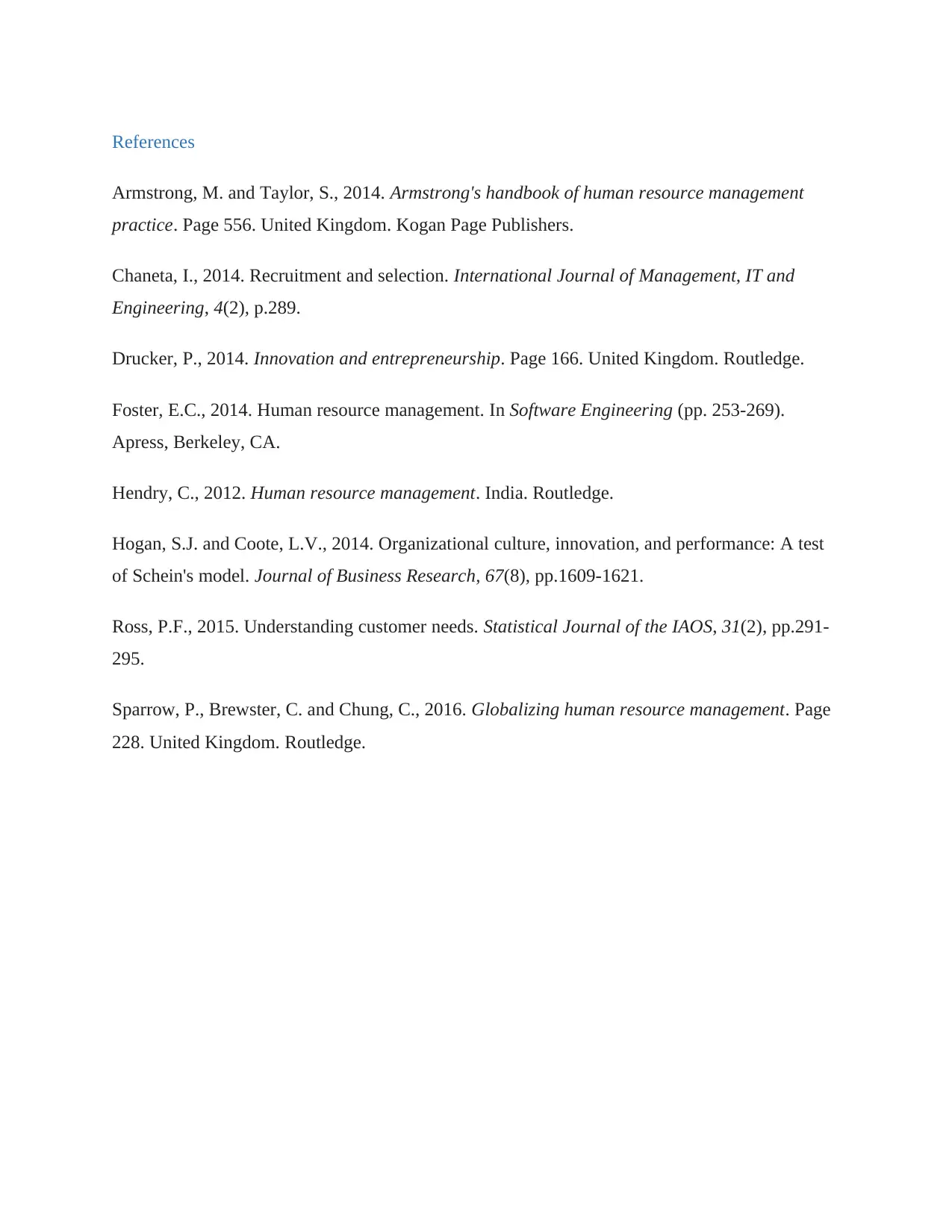Exploring Strategic Human Resource Management - Essay & Solution
VerifiedAdded on 2023/06/15
|5
|1459
|104
Essay
AI Summary
This essay discusses human resource management (HRM) as a strategic and coherent approach to managing an organization's most valued assets: its people. It highlights the importance of HRM in recruiting, creating a positive work culture, and aligning employee goals with organizational objectives. The essay emphasizes that employees are crucial for innovation, financial management, and understanding consumer needs. While technology plays a significant role, the essay argues that human input remains irreplaceable. Ultimately, the essay concludes that effective HRM is essential for the growth and success of any business, as employees drive the organization forward.

Human resource management
Essay
Essay
Paraphrase This Document
Need a fresh take? Get an instant paraphrase of this document with our AI Paraphraser

Essay Topic
Human resource management is the strategic and coherent approach to the management of
an organization’s most valued assets.
Human resource management of any organization is associated with managing people of the
organization. It is considered to be one of the most crucial functions of the business owing to the
fact that people of any organization form the backbone of the business (Hendry, 2012). The term
strategic in my opinion refers to the long term association of the subject. Human resource
management of any business keeps the long term interests in mind while managing the most
valued assets of the business. A Coherent HRM refers to the logical and rational management of
human resources. This is imperative for any business in order to effectively manage employees.
Therefore, I am in complete agreement with the essay topic which states that human resource
management is the strategic and coherent approach to the management of an organization’s most
valued assets. This essay throws light on various examples depicting the importance of the
human resources of any business as well as how different HRM functions of different
organizations manage this resource.
Human resource management begins at recruiting the right set of employees for the right role
and at the right time in any business (Chaneta, 2014). Hence employees enable businesses to
function effectively and accomplish organizational goals. These right set of the employees are
the ones who are working towards fulfilling different roles in the business. It is owing to these
employees that the smallest of the business processes are accomplished in an effective manner.
People of the business form the business. The idea of any business begins with a person and
grows into a team of people. Therefore people are those founding stones for the success of any
business (Drucker, 2014). There are various businesses like the Apple Inc. that started in a
garage with a dearth of money and technology, however, it was just the spirit of the people
behind the organization that has made it into a multibillion-dollar firm that is ruling the
technology industry.
One important role played by employees is of creating the work culture of the business. This
business environment plays a very important role in ensuring how organizational goals are met.
Human resource management is the strategic and coherent approach to the management of
an organization’s most valued assets.
Human resource management of any organization is associated with managing people of the
organization. It is considered to be one of the most crucial functions of the business owing to the
fact that people of any organization form the backbone of the business (Hendry, 2012). The term
strategic in my opinion refers to the long term association of the subject. Human resource
management of any business keeps the long term interests in mind while managing the most
valued assets of the business. A Coherent HRM refers to the logical and rational management of
human resources. This is imperative for any business in order to effectively manage employees.
Therefore, I am in complete agreement with the essay topic which states that human resource
management is the strategic and coherent approach to the management of an organization’s most
valued assets. This essay throws light on various examples depicting the importance of the
human resources of any business as well as how different HRM functions of different
organizations manage this resource.
Human resource management begins at recruiting the right set of employees for the right role
and at the right time in any business (Chaneta, 2014). Hence employees enable businesses to
function effectively and accomplish organizational goals. These right set of the employees are
the ones who are working towards fulfilling different roles in the business. It is owing to these
employees that the smallest of the business processes are accomplished in an effective manner.
People of the business form the business. The idea of any business begins with a person and
grows into a team of people. Therefore people are those founding stones for the success of any
business (Drucker, 2014). There are various businesses like the Apple Inc. that started in a
garage with a dearth of money and technology, however, it was just the spirit of the people
behind the organization that has made it into a multibillion-dollar firm that is ruling the
technology industry.
One important role played by employees is of creating the work culture of the business. This
business environment plays a very important role in ensuring how organizational goals are met.

Work culture creates trust, respect, and communication (Hogan & Coote, 2014). Human resource
management leads to strategic management of these employees and this helps in building a
positive culture across the business. Organizations like Value Corp. have a flat structure. On the
other hand, organizations like The Deccan have a hierarchical structure. This structure greatly
impacts the culture followed throughout the business. Since this structure and culture are both
defined by the people of the business, they are undoubtedly one of the most important resources
for a business.
Technology advancement is evident across all the businesses. Various manpower is getting
replaced by machines. However, it is important to understand that the dependency between
humans and the technology operated in a two-way street. Given the increasing use of technology,
people largely find themselves dependent on various forms of technology. Businesses have
become more efficient and competitive with the effective use of technology. But the dependence
of technology upon the people operating it is irreplaceable. It is naïve to presume that Google,
one of the world’s most technologically advanced firm can function without people. Employees
operate technology and we have yet not reached the stage where businesses can be solely run by
technology alone.
Most businesses begin with the aim of creating a profit. They exist because they cater to some
need and fulfill some gap that exists within consumers today. It is the employees of the business
that articulate goals of the business. They understand consumer needs and work towards filling
that gap (Ross, 2015). Without employees, it would be impossible to gauge the need that exists
in the market and hence the goal of the business becomes vague. Therefore managing employees
also lead to better understanding of consumer needs and hence improved growth of the business.
For the establishment and the continued growth of the business, money plays a vital role.
Without sufficient finances, it is highly difficult for a business to fulfill its basic processes. This
is why management of this money or financial management forms a crucial part of any
organization. However, it is the employees of the business who work towards arranging,
managing and earning more money through and for the business that they are associated with.
Hence, it is safe to conclude that employee management or human resource management of any
management leads to strategic management of these employees and this helps in building a
positive culture across the business. Organizations like Value Corp. have a flat structure. On the
other hand, organizations like The Deccan have a hierarchical structure. This structure greatly
impacts the culture followed throughout the business. Since this structure and culture are both
defined by the people of the business, they are undoubtedly one of the most important resources
for a business.
Technology advancement is evident across all the businesses. Various manpower is getting
replaced by machines. However, it is important to understand that the dependency between
humans and the technology operated in a two-way street. Given the increasing use of technology,
people largely find themselves dependent on various forms of technology. Businesses have
become more efficient and competitive with the effective use of technology. But the dependence
of technology upon the people operating it is irreplaceable. It is naïve to presume that Google,
one of the world’s most technologically advanced firm can function without people. Employees
operate technology and we have yet not reached the stage where businesses can be solely run by
technology alone.
Most businesses begin with the aim of creating a profit. They exist because they cater to some
need and fulfill some gap that exists within consumers today. It is the employees of the business
that articulate goals of the business. They understand consumer needs and work towards filling
that gap (Ross, 2015). Without employees, it would be impossible to gauge the need that exists
in the market and hence the goal of the business becomes vague. Therefore managing employees
also lead to better understanding of consumer needs and hence improved growth of the business.
For the establishment and the continued growth of the business, money plays a vital role.
Without sufficient finances, it is highly difficult for a business to fulfill its basic processes. This
is why management of this money or financial management forms a crucial part of any
organization. However, it is the employees of the business who work towards arranging,
managing and earning more money through and for the business that they are associated with.
Hence, it is safe to conclude that employee management or human resource management of any
⊘ This is a preview!⊘
Do you want full access?
Subscribe today to unlock all pages.

Trusted by 1+ million students worldwide

business also results in better financial management and financial risk assessment for the
business (Armstrong & Taylor, 2014).
Human resource management also associates itself working towards retaining employees and
ensuring their long-term tenure in the business. This process is strategic as well as coherent in
nature as it involves aligning employees’ goals with those of the organization. This further
proves the topic. Hence human resource management regards to the management of the most
valuable assets of the business.
There are various leading businesses that require cognitive skills, creativity, hard work and
effective articulation of data. With the increasing number of businesses, the number of
competent people required for every business also rises. This role cannot be fulfilled by any
other resource of the business. Hence effective employee management also means that the
competent employees of the business will continue to move the business in the direction of
growth and innovation (Sparrow, Brewster & Chung, 2016). Besides money, technology, and
infrastructure, other aspects of the business like knowledge, ideation, and creativity of the
employees also compose an important resource for the business.
In conclusion, it is fair to say that even though the employees or the human resources of any
business form the most important part of the business. Employees are undoubtedly the most
valued assets of any organization. For employees to be able to run the business and lead it to the
pinnacle of success, other resources are required as a mere support system. This includes
technology, infrastructure, finances as well as intellectual. However, the ultimate goal of these
resources is to assist the people of the business to run the organization in an efficient manner
(Foster, 2014). Therefore, it is absolutely alright to say that human resource management is the
strategic and coherent function of managing the most valued assets of any business. It is these
people who introduce the idea of a business, who manage the finances, who run the technology,
who reach out to consumers and who generate revenue and grow the business in the longer run.
Therefore, for the growth and success of any business, it is imperative to value the most
important resources, the people associated with the business.
business (Armstrong & Taylor, 2014).
Human resource management also associates itself working towards retaining employees and
ensuring their long-term tenure in the business. This process is strategic as well as coherent in
nature as it involves aligning employees’ goals with those of the organization. This further
proves the topic. Hence human resource management regards to the management of the most
valuable assets of the business.
There are various leading businesses that require cognitive skills, creativity, hard work and
effective articulation of data. With the increasing number of businesses, the number of
competent people required for every business also rises. This role cannot be fulfilled by any
other resource of the business. Hence effective employee management also means that the
competent employees of the business will continue to move the business in the direction of
growth and innovation (Sparrow, Brewster & Chung, 2016). Besides money, technology, and
infrastructure, other aspects of the business like knowledge, ideation, and creativity of the
employees also compose an important resource for the business.
In conclusion, it is fair to say that even though the employees or the human resources of any
business form the most important part of the business. Employees are undoubtedly the most
valued assets of any organization. For employees to be able to run the business and lead it to the
pinnacle of success, other resources are required as a mere support system. This includes
technology, infrastructure, finances as well as intellectual. However, the ultimate goal of these
resources is to assist the people of the business to run the organization in an efficient manner
(Foster, 2014). Therefore, it is absolutely alright to say that human resource management is the
strategic and coherent function of managing the most valued assets of any business. It is these
people who introduce the idea of a business, who manage the finances, who run the technology,
who reach out to consumers and who generate revenue and grow the business in the longer run.
Therefore, for the growth and success of any business, it is imperative to value the most
important resources, the people associated with the business.
Paraphrase This Document
Need a fresh take? Get an instant paraphrase of this document with our AI Paraphraser

References
Armstrong, M. and Taylor, S., 2014. Armstrong's handbook of human resource management
practice. Page 556. United Kingdom. Kogan Page Publishers.
Chaneta, I., 2014. Recruitment and selection. International Journal of Management, IT and
Engineering, 4(2), p.289.
Drucker, P., 2014. Innovation and entrepreneurship. Page 166. United Kingdom. Routledge.
Foster, E.C., 2014. Human resource management. In Software Engineering (pp. 253-269).
Apress, Berkeley, CA.
Hendry, C., 2012. Human resource management. India. Routledge.
Hogan, S.J. and Coote, L.V., 2014. Organizational culture, innovation, and performance: A test
of Schein's model. Journal of Business Research, 67(8), pp.1609-1621.
Ross, P.F., 2015. Understanding customer needs. Statistical Journal of the IAOS, 31(2), pp.291-
295.
Sparrow, P., Brewster, C. and Chung, C., 2016. Globalizing human resource management. Page
228. United Kingdom. Routledge.
Armstrong, M. and Taylor, S., 2014. Armstrong's handbook of human resource management
practice. Page 556. United Kingdom. Kogan Page Publishers.
Chaneta, I., 2014. Recruitment and selection. International Journal of Management, IT and
Engineering, 4(2), p.289.
Drucker, P., 2014. Innovation and entrepreneurship. Page 166. United Kingdom. Routledge.
Foster, E.C., 2014. Human resource management. In Software Engineering (pp. 253-269).
Apress, Berkeley, CA.
Hendry, C., 2012. Human resource management. India. Routledge.
Hogan, S.J. and Coote, L.V., 2014. Organizational culture, innovation, and performance: A test
of Schein's model. Journal of Business Research, 67(8), pp.1609-1621.
Ross, P.F., 2015. Understanding customer needs. Statistical Journal of the IAOS, 31(2), pp.291-
295.
Sparrow, P., Brewster, C. and Chung, C., 2016. Globalizing human resource management. Page
228. United Kingdom. Routledge.
1 out of 5
Related Documents
Your All-in-One AI-Powered Toolkit for Academic Success.
+13062052269
info@desklib.com
Available 24*7 on WhatsApp / Email
![[object Object]](/_next/static/media/star-bottom.7253800d.svg)
Unlock your academic potential
Copyright © 2020–2025 A2Z Services. All Rights Reserved. Developed and managed by ZUCOL.




